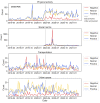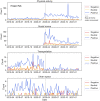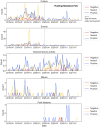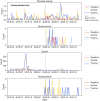Exploring public values through Twitter data associated with urban parks pre- and post- COVID-19
- PMID: 35966883
- PMCID: PMC9358034
- DOI: 10.1016/j.landurbplan.2022.104517
Exploring public values through Twitter data associated with urban parks pre- and post- COVID-19
Abstract
Since school and business closures due to the evolving COVID-19 outbreak, urban parks have been a popular destination, offering spaces for daily fitness activities and an escape from the home environment. There is a need for evidence for parks and recreation departments and agencies to base decisions when adapting policies in response to the rapid change in demand and preferences during the pandemic. The application of social media data analytic techniques permits a qualitative and quantitative big-data approach to gain unobtrusive and prompt insights on how parks are valued. This study investigates how public values associated with NYC parks has shifted between pre- COVID (i.e., from March 2019 to February 2020) and post- COVID (i.e., from March 2020 to February 2021) through a social media microblogging platform -Twitter. A topic modeling technique for short text identified common traits of the changes in Twitter topics regarding impressions and values associated with the parks over two years. While the NYC lockdown resulted in much fewer social activities in parks, some parks continued to be valued for physical activity and nature contact during the pandemic. Concerns about people not keeping physical distance arose in parks where frequent human interactions and crowding seemed to cause a higher probability of the coronavirus transmission. This study demonstrates social media data could be used to capture park values and be specific per park. Results could inform park management during disruptions when use is altered and the needs of the public may be changing.
Keywords: Big data; GSDMM topic modeling; Pandemic; Public values; Social media; Topic modeling; Urban greenspaces.
© 2022 Elsevier B.V. All rights reserved.
Conflict of interest statement
The authors declare that they have no known competing financial interests or personal relationships that could have appeared to influence the work reported in this paper.
Figures
















Similar articles
-
Change of urban park usage as a response to the COVID-19 global pandemic.Sci Rep. 2023 Nov 7;13(1):19324. doi: 10.1038/s41598-023-46745-1. Sci Rep. 2023. PMID: 37935778 Free PMC article.
-
Impacts of COVID-19 pandemic on urban park visitation: a global analysis.J For Res (Harbin). 2021;32(2):553-567. doi: 10.1007/s11676-020-01249-w. Epub 2020 Nov 12. J For Res (Harbin). 2021. PMID: 33204057 Free PMC article.
-
COVID-19 pandemic changes the recreational use of Moscow parks in space and time: Outcomes from crowd-sourcing and machine learning.Urban For Urban Green. 2023 May;83:127911. doi: 10.1016/j.ufug.2023.127911. Epub 2023 Mar 22. Urban For Urban Green. 2023. PMID: 36987409 Free PMC article.
-
Survive, revive, and thrive: The impact of COVID-19 on global park visitation.Sci Total Environ. 2024 Oct 10;946:174077. doi: 10.1016/j.scitotenv.2024.174077. Epub 2024 Jun 20. Sci Total Environ. 2024. PMID: 38908585
-
How Much Did Urban Park Use Change under the COVID-19 Pandemic? A Comparative Study of Summertime Park Use in 2019 and 2020 in Edinburgh, Scotland.Int J Environ Res Public Health. 2023 Oct 31;20(21):7001. doi: 10.3390/ijerph20217001. Int J Environ Res Public Health. 2023. PMID: 37947559 Free PMC article.
Cited by
-
Contesting views on mobility restrictions in urban green spaces amid COVID-19-Insights from Twitter in Latin America and Spain.Cities. 2023 Jan;132:104094. doi: 10.1016/j.cities.2022.104094. Epub 2022 Nov 10. Cities. 2023. PMID: 36407936 Free PMC article.
-
The Factors and Relationships Influencing Forest Hiking Exercise Characteristics after COVID-19 Occurrence: At Seoul Metropolitan Area and in Hikers' 20s and 30s.Int J Environ Res Public Health. 2022 Dec 7;19(24):16403. doi: 10.3390/ijerph192416403. Int J Environ Res Public Health. 2022. PMID: 36554284 Free PMC article.
-
Exploring the impact of pandemic fear on visitation to park attractions in urban city: A case study in Seoul, South Korea.PLoS One. 2024 Apr 16;19(4):e0301869. doi: 10.1371/journal.pone.0301869. eCollection 2024. PLoS One. 2024. PMID: 38625971 Free PMC article.
-
A longitudinal analysis of usage patterns, topics, and information dissemination related to five names for cultured meat on social media.Curr Res Food Sci. 2024 Sep 16;9:100859. doi: 10.1016/j.crfs.2024.100859. eCollection 2024. Curr Res Food Sci. 2024. PMID: 39958967 Free PMC article.
-
An overview of urban analytical approaches to combating the Covid-19 pandemic.Environ Plan B Urban Anal City Sci. 2023 Jun;50(5):1133-1143. doi: 10.1177/23998083231174748. Epub 2023 May 4. Environ Plan B Urban Anal City Sci. 2023. PMID: 38602958 Free PMC article. No abstract available.
References
-
- Abusaada H., Elshater A. COVID-19’s challenges to urbanism: Social distancing and the phenomenon of boredom in urban spaces. Journal of Urbanism: International Research on Placemaking and Urban Sustainability. 2020;1–3 doi: 10.1080/17549175.2020.1842484. - DOI
-
- Alieva D., Holgado D., de Juan S., Ruiz-Frau A., Villasante S., Maya-Jariego I. Assessing landscape features and ecosystem services of marine protected areas through photographs on social media: Comparison of two archipelagos in Spain. Environment, Development and Sustainability. 2021 doi: 10.1007/s10668-021-01841-y. - DOI
-
- Brandwatch. (2018). Brandwatch launches instant social research tool to help marketers reach the right audiences. Retrieved from https://www.brandwatch.com/press/press-releases/brandwatch-launches-inst....
LinkOut - more resources
Full Text Sources

